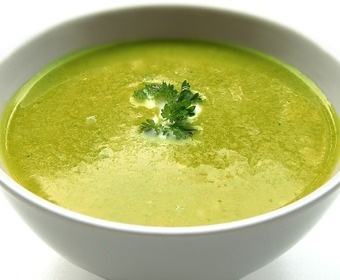
12 things you need to know about vegetable soup
- Be meticulous with the basics
- Pump up the flavors
- Put a little love on garnish
A smooth, blended soup made from vegetables is the easiest dish in the world – and very tasty and satisfying if you get it right. You might think that it’s just about pouring chopped vegetables in a pot of water, boiling them, and hitting it with your hand mixer. But it’s not quite that easy. Some tips from the pros:
The foundation is everything in soup
It obviously matters what vegetables you choose for your soup, but to make them shine the ground work must be rock solid. Professional chefs always start from a real, homemade stock, and this is how it’s done in the vegetable world:
Fry the onions to tastiness
Onions, in one form or another, are almost obligatory in any kind of stock. And onions taste best when they have been sweated so that the sweet, caramel-like flavors are allowed to evolve before you go on to the next step. To maximize flavors, fry the onions in butter in the same pot as you will be using for your soup.
Other greens that make a great base:
Celery Not everyone is a fan of this vegetable and its adult flavor, but as a part of a larger composition it has a unique way of lifting all flavors.
Parsley. A relative of celery, and with a similar ability to bring new dimensions to other ingredients. Throwing away the parsley stems is a waste of great flavors, add them to your soup, simmer, and blend with a hand mixer.
Garlic. Just a clove or two. It must not take over the show – unless it is garlic soup you are making.
Heavy (whipping) cream. Any added cream should go in at the end – and this is where opinions differ: Some chefs almost want the soup to taste of cream, others just want a hint that does not douse the freshness of the vegetables. But just a dash (two dashes if it is light cream) works wonders.
Boost the flavors
What makes a vegetable soup exciting are the mild, nuanced, fragrant flavors of the vegetables themselves. Use fat, saltiness and sweetness in one form or another to make them pop. Black pepper and lemon will also lift flavors. A light touch of chili also makes a soup more satisfying – but only a little, so that you just sense it in every spoon.
Vegetarian but not 1
A good trick for bringing out the best in vegetable soup is to use chicken stock. If you are a strict vegetarian you can add umami in the form of seaweed, for example kelp/kombu. (But beware of overdoing it, too much of this ingredient will taste like “warm puddle” rather than “sea”.)
Vegetarian but not 2
Animal fats also have a way of boosting vegetable flavors. For example, fry onion and other greens in butter. Or – if you happen to have some in your fridge – in duck or chicken fat.
Simmer soup ”long enough”
Not too long, so that you preserve the pretty color of, for example, a butterscotch pumpkin. But long enough to get a silky smooth soup when you apply your hand mixer.
Spend a moment on garnish
A deep dish with smooth soup is not the most eye-catching food you can put on the table. Plan ahead and save some pretty, colorful pieces of the ingredients – for example, fresh parsley, roasted seeds from the pumpkin, or razor thin slices of the green part of a leek – for garnish. A few drops of virgin olive oil and some freshly ground pepper will also do.
For those who ”don’t like soup”
If you have a soup skeptic at the table you can silence them with newly baked bread and an assortment of cheeses. Some people take more time growing up than others…
Green leftovers from the fridge
The green leaves around cauliflower, the stem from both cauliflower and broccoli, that lonely carrot that has gone limp, the green part of leeks, the stem from parsley, etc. In a smooth, blended soup these “leftovers” all add some notes in an orchestra of flavors.
Straight from the pros
Building your vegetable soup with the help of green ”leftovers” is neither unsightly nor ungenerous. On the contrary, in the professional kitchen you will find a total respect for fresh produce, flavors, husbandry and economy. This means making the most of every ingredient.
Not only will the soup be more tasty, it will also cost less and be more nutritious and you will help to reduce the waste that is making a mess of our planet. (Slowly but surely this message is coming across to home cooks around the world, but not fast enough. Please help spread it.)
Bubbly with soup
It’s hard to say exactly what it is that does it, but nothing beats a bubbly white wine with this kind of soup. Try it.


